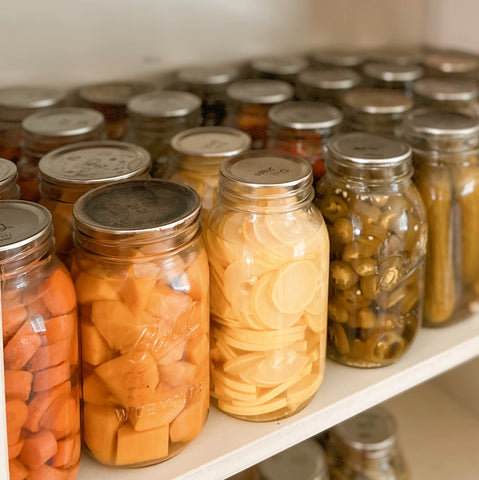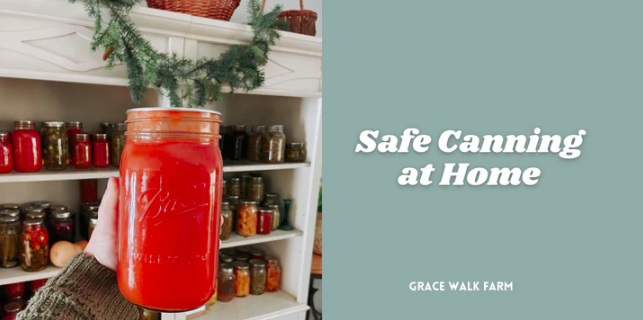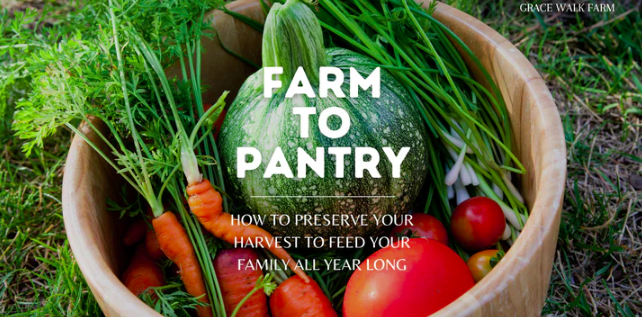When it comes to canning, safety is the most important thing. You don’t want to make yourself or your family sick, so stick to safe canning methods and tested recipes. Proper canning practices can prevent the growth of harmful bacteria and ensure the SAFE preservation of food. Here are some of the most important rules to remember for canning safety.
Welcome to Grace Walk Farm, our family homestead in western NC. We share the highs and lows of our homestead journey, in hopes that it will encourage you to grow your own food too. Click here to grab our Beginner Garden Guide for free! Join our 600K strong Instagram community of homesteaders here. Thanks for stopping by!
Watch my canning for beginners class here.

Use reliable, research-based canning recipes
It’s crucial to use trusted recipes from reputable sources, such as the National Center for Home Food Preservation, USDA, or your local cooperative extension office. These recipes have been tested and developed to ensure safe canning practices.
Its okay to vary spices and customize recipes, but you need to know the proper method for the food you are preserving and that’s where the need for a recipe comes into play.

Follow proper canning methods
There are three primary methods of canning: water bath canning and steam canning for high-acid foods, and pressure canning for low-acid foods. Use the appropriate method based on the food you’re canning to ensure the correct processing time, temperature, and pressure.
If this feels confusing, grab my Home Canning for Beginners book. It includes lists of which foods can be processed with each method, plus explains how they are different.

Maintain correct processing times and temperatures
Follow the recommended processing times and temperatures specified in the canning recipe. This ensures that the food is heated to a temperature that kills bacteria and other microorganisms that can cause spoilage or foodborne illnesses.

Use the right equipment
Use canning equipment that is in good condition, including canners, jars, lids, and bands. Check jars for any cracks or chips, and ensure that the lids and bands are free of rust. Follow the manufacturer’s instructions for the proper use and maintenance of your canning equipment.
Practice proper hygiene and cleanliness
Wash your hands thoroughly before handling any food or equipment for canning. Keep the work area clean and sanitize utensils, cutting boards, and other surfaces that come into contact with the food.

Prepare food properly
Clean and prepare the fruits, vegetables, or other ingredients according to the canning recipe. Remove any damaged or spoiled portions and ensure that the food is fresh and of high quality.
Use appropriate jars and lids
Only use jars specifically designed for home canning. Regular glass jars, such as those used for commercial food products, may not be suitable for canning as they may not withstand the high temperatures and pressures involved. Use new lids for each canning session, as reusing lids can compromise the seal.
Ventilate pressure canners properly
If using a pressure canner, ensure that you vent it according to the manufacturer’s instructions before placing the weight or closing the vent. This ensures that any trapped air is released and the proper pressure can be reached during processing.
Test jar seals
After the jars have cooled, check the seals to ensure they are properly sealed. Press down on the center of the lid to check for a concave shape. If the lid pops up and down, the jar is not sealed, and the food should be refrigerated or reprocessed using new lids.
Store canned goods properly
After canning, store the jars somewhere temperatures remain fairly constant. Avoid storing them in areas that are prone to temperature fluctuations or excessive heat, as this can affect the quality and safety of the canned food.
By following these important rules for canning safety, you can minimize the risk of foodborne illnesses and ensure the safe preservation of your home-canned foods.

Use code GRACEWALK10 for 10% off on my favorite canning lids.
Also check out these blogs:


